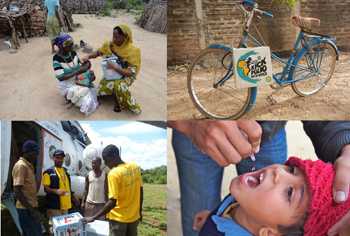Global Polio Eradication: Reaching Every Last Child
Tuesday, February 17 at 1pm EST.
 Polio is a crippling and potentially deadly infectious disease. The virus spreads from person to person and can invade an infected person’s spinal cord, causing life-long paralysis or in rare instances, death. The eradication of polio remains an important priority for the CDC and many of its global partners. Over the past 25 years, the number of polio cases reported worldwide has fallen from an estimated 350,000 in 1988 to only 407 in 2013—a decline of more than 99%, but there remains work to be done.
Polio is a crippling and potentially deadly infectious disease. The virus spreads from person to person and can invade an infected person’s spinal cord, causing life-long paralysis or in rare instances, death. The eradication of polio remains an important priority for the CDC and many of its global partners. Over the past 25 years, the number of polio cases reported worldwide has fallen from an estimated 350,000 in 1988 to only 407 in 2013—a decline of more than 99%, but there remains work to be done.
Currently, four regions of the world (the Americas, Europe, South East Asia and the Western Pacific) are certified polio free, but in a small number of countries the spread of this disease has never stopped, putting all the countries of the world at risk. Polio has no cure, making vaccination the only way to eradicate it. However, continued conflict, political instability, hard-to-reach populations, and attempts to ban vaccination in some areas continue to pose complex challenges and threaten to derail decades of work.
Please join us for this session of Grand Rounds as we investigate the efforts of those fighting against polio. Specifically, this session will highlight innovative strategies being used in countries affected by insecurity to accelerate immunization and surveillance efforts to ultimately reach every last child and make the world polio free.
Presentation
February 2015
Beyond the Data Beyond brings you "take home" messages for you to use in your practice, in your classroom and in your home.Dr. Phoebe Thorpe and Dr. Elias Durry discuss the challenges in eradicating polio worldwide. Reaching every last child and making the world polio free is possible, but everyone has to do their part.
- Public health agencies must continue to strengthen surveillance systems and immunization programs,
- Governments must support the efforts of vaccinators by ensuring safe environments to work and
- Community leaders must partner with vaccinators to educate their communities.
Presented By:
Gregory L. Armstrong, MD
Chief, Polio Eradication Branch
Global Immunization Division
Center for Global Health, CDC
“Polio Eradication in the Emergency Phase”
M. Steven Oberste, PhD
Chief, Polio and Picornavirus Laboratory Branch
Division of Viral Diseases
National Center for Immunization and Respiratory Diseases, CDC
“The Global Polio Laboratory Network—Continuous Innovation and Quality Control”
Faisal Shuaib, MD, DrPH
Deputy Incident Manager for Polio
Polio Emergency Operations Center
Abuja, Nigeria
“Progress on Polio Eradication: Strategies and Innovations in Nigeria”
Elias Durry, MD, MPH
Senior Emergency Coordinator for Polio Eradication in Pakistan
Eastern Mediterranean Regional Office, World Health Organization
“Public Health Amidst Insecurity: Pakistan’s Polio Eradication Initiative”
Facilitated By:
John Iskander, MD, MPH, Scientific Director, Public Health Grand Rounds
Phoebe Thorpe, MD, MPH, Deputy Scientific Director, Public Health Grand Rounds
Susan Laird, MSN, RN, Communications Director, Public Health Grand Rounds
Additional Resources:
Continuing Education
This session is available for Continuing Education. Click here for more information.
- Page last reviewed: February 23, 2015
- Page last updated: February 23, 2015
- Content source:
- Centers for Disease Control and Prevention
- Page maintained by: Office of Associate Director of Communication, Division of Public Affairs



 ShareCompartir
ShareCompartir